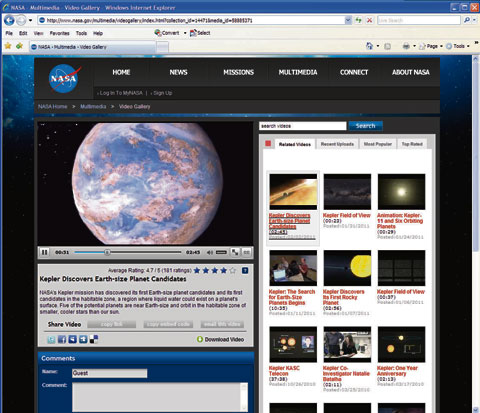Nasa’s Kepler mission has discovered its first Earth-sized planet candidates, and the first candidates in a habitable zone, or so New Scientist and Nature
magazines reported last week.
The findings are based on the results of observations by Nasa’s Kepler space telescope, conducted between 12 May and 17 September 2009. Kepler’s field of view, which covers approximately 1/400 of the sky, observes more than 156,000 stars virtually continuously. Based on Kepler’s data, Nasa scientists identified 1,235 planet candidates.
Of these planets, 54 are situated in habitable zones in relation to their stars, where liquid water – and thus perhaps life – could potentially exist.
“They selected a direction rich in stars that are comparable in size with our sun, or smaller,” explains Professor Imke de Pater (Aerospace Engineering). The reasons for this were pragmatic: planets rotating around larger stars are harder to detect, and small stars tend to form stable planetary systems.
The Kepler space telescope detects planets around stars by using a method that measures small dips in the star’s brightness. This observational method was first proposed by Nasa’s Dr Bill Borucki, who had to convince many people that his method would actually work.
“The difference in brightness is extremely small,” explains Prof. De Pater, as she scrolls through the Nature article on her laptop. A planet passing in front of a star may reduce its brightness by as little as 0.005 percent. “I wouldn’t have liked to work out the observations,” she says, “but I do enjoy the results.”
A selection of the newly found planets has subsequently been observed by larger, Earth-based telescopes as well. Here the observational method used is to measure the rotation speed of the planets (by measuring the Doppler shift in stellar absorption lines). Combined with the angular velocity, which follows from the observed periodicity of the planet around its star, the velocity allows scientists to calculate the mass. Based on the amount of dimming in the starlight, scientists can then determine the planet’s diameter and thus calculate its density.
As of yet there is no information available about the planets’ atmospheres, although Prof. De Pater believes that some day it should be possible to use spectroscopy for detecting the presence of certain elements in a planet’s atmosphere. Absorption lines should show up in the star’s spectrum when the planet passes in front of the star.
Spectroscopic analysis of the atmospheres of Earth-like planets could well become the next major space mission. “These Kepler findings will undoubtedly give rise to new mission proposals,” Prof. De Pater believes.
One of Kepler’s findings is six confirmed planets orbiting a sun-like star, named Kepler-11, located approximately 2,000 light years from Earth. This is the largest group of planets orbiting a single star yet discovered outside our solar system. All six of the confirmed planets have orbits smaller than Venus’, and five of the six have orbits smaller than Mercury’s. The Kepler-11 findings were published in the February 3rd issue of the journal Nature.
“This is a very special discovery,” says exo-planets expert Daphne Stam, who works for the Netherlands Institute for Space Research and is one of the teachers of the MSc planetary science programme at the faculty of Aerospace Engineering.
“These planets are orbiting so closely to one another that they influence each other’s orbit,” she explains. “It’s therefore also possible to calculate their mass.”
Researchers can deduce the sizes of the planets from their speed of rotation and the decreases in the star’s brightness when the planets pass in front of them. By combining this information with the mass, they can calculate the density of the planets and subsequently deduce what the planets are made of. “In this star system all information comes together,” Stam concludes.
Delta, 17-11-2005
Never again having to struggle with rubbers. The Delft student company MungosWorks developed a radical new way to put on a condom.
When it’s dark and you’ve had a few drinks, many men struggle to get the condom pack open, and it’s also often frustratingly hard to figure out what side of the rubber is up. Not the best way to stay in the mood for having sex. One night, however, inventor and former student mechanical engineering Adnan Tunovic had enough of this irritating process. The next morning he came up with an idea: Wingman, an inventive condom clip, which has made struggling with rubbers a thing of the past. “The clip is already on the condom when it is still in the package. The clip shows you what side is up, and then all you have to do is unroll it on the penis. This only takes three seconds and you can do it with one hand,” explains Tunovic, who is the director of MungosWorks.
Five years ago Delta was the first to publish an article about Wingman. After that the condom gadget became a media hype. Tunovic appeared on Dutch TV shows like ‘De Wereld Draait Door’ and ‘Hart van Nederland’. Newspapers and magazines like NRC Handelsblad and Der Spiegel wrote about his invention. One of Holland’s best-known players, dj Jean, said he couldn’t wait to use Wingman. Bags full of mail from desperate condom users arrived at the MungosWorks office in Delft.
It was the best possible publicity a product could get to take over the condom market; however, five years later and Wingman is still not on the market. “It’s been very difficult to find an investor”, Tunovic says. “We were close to a deal with a company in 2008.” But the financial crisis made investors hesitant. “Condom suppliers want us to make a series of 100,000 Wingmans. That way people can test it on a large scale and it will show that it makes using a condom so much easier. To make 100,000 Wingmans however we need to create a stamper, buy condoms, set up a semi-automatic assembly line and have Wingman certified.” That will cost 200,000 euro. Nobody yet wants to invest the money to set this up.
Tunovic still believes in his product and is convinced that the clip will be a success. “Every month we get letters about Wingman”, he adds. “I’ve used the prototypes, so I know they work very well. Although I don’t use them anymore, because I got married.



Comments are closed.